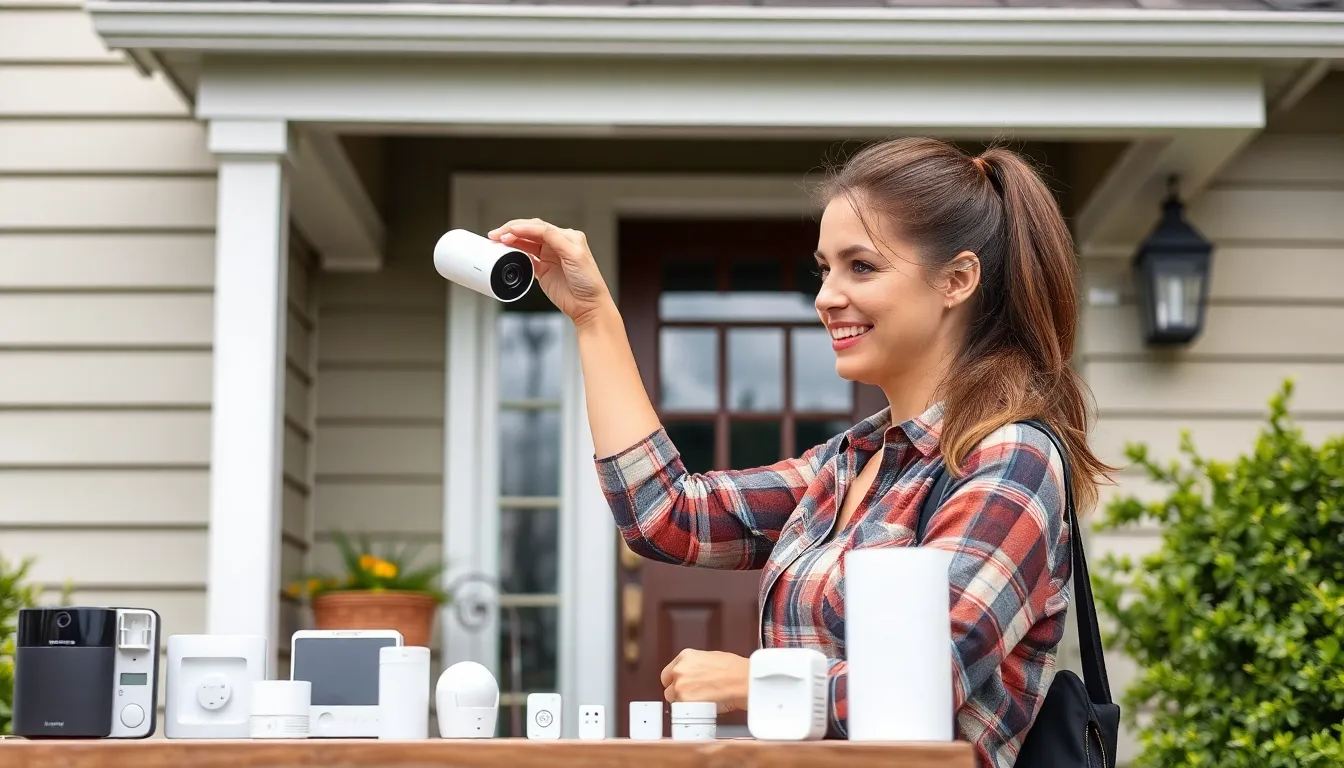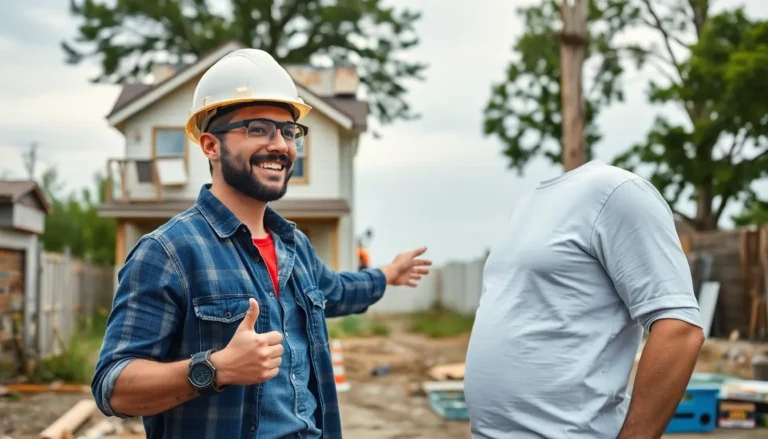In a world where home invasions can happen faster than you can say “I forgot to lock the door,” DIY home security has never been more essential. Who needs a superhero when you can be your own? With a few simple tools and a dash of creativity, anyone can transform their home into a fortress without breaking the bank.
Table of Contents
ToggleOverview of DIY Home Security
DIY home security empowers individuals to protect their homes effectively. Many homeowners prefer this approach due to its cost-effectiveness. Various tools and solutions can enhance safety without professional installation.
First, installing smart cameras provides real-time video feeds and alerts on suspicious activity. Individuals often choose user-friendly devices compatible with smartphones for easy monitoring. These cameras help deter intruders as well.
Second, motion-sensor lights serve as another valuable component. These lights illuminate areas when they detect movement, making properties less appealing to burglars. Areas around entrances and driveways benefit significantly from this addition.
Third, security alarms can play a crucial role. Many affordable options offer loud sirens and connectivity to smartphones. The presence of an alarm can deter unwanted visitors.
Fourth, reinforcing doors and windows adds extra security layers. Stronger locks, door bars, and window films can make entry points less accessible. Individuals can install these modifications without extensive expertise.
Fifth, neighborhood watch programs strengthen community safety. Residents collaborating on security efforts can reduce crime rates. Sharing surveillance footage and observations fosters a protective environment.
Finally, engaging children in safety discussions is essential. Families can establish routines to ensure everyone understands home security measures. Ensuring that every family member knows what to do in emergencies creates a safer living space.
Exploring these DIY home security strategies allows homeowners to prioritize their safety proactively. Simple actions, combined with community support, enhance the overall security of residential areas.
Benefits of DIY Home Security

DIY home security offers several advantages. Homeowners gain control over their safety while often saving money.
Cost Effectiveness
Budget-conscious individuals find DIY home security to be an attractive option. Costs associated with traditional security systems can exceed $1,000 annually, while DIY solutions typically range from $100 to $500 for essential equipment. Homeowners avoid installation fees by setting up devices themselves. Savings increase with every part of the system, from cameras to alarms. Maintaining a DIY security system involves minimal recurring expenses compared to professional services. Flexibility in selecting only necessary items enhances the overall affordability.
Customization Options
With DIY security, customization caters to individual needs. Homeowners choose features that fit their specific concerns, such as outdoor cameras for monitoring yards or smart locks for added door protection. Unique systems develop from a combination of preferred devices and technologies. Flexibility becomes paramount when addressing specific vulnerabilities, allowing for tailored setups. Homeowners can adapt systems over time, adding new technologies as needed without needing to replace entire setups. Each decision emphasizes personal safety while addressing individual lifestyles and home layouts.
Essential Components of DIY Home Security Systems
DIY home security consists of several essential components that help protect against intrusions. Homeowners can choose from various solutions tailored to their preferences and needs.
Security Cameras
Security cameras serve as a vital element in any DIY home security system. They provide real-time monitoring and can deter potential intruders. Various options exist, including indoor cameras for tracking activity inside the home and outdoor cameras that cover entry points. Motion detection features enhance their effectiveness by triggering alerts when movement occurs. Some models even offer smartphone integration, allowing homeowners to access live feeds remotely.
Alarm Systems
Alarm systems add an additional layer of security to homes. These systems typically sound loud sirens when unauthorized access is detected, which can startle intruders and alert neighbors. Wireless options are widely available, simplifying installation without the need for extensive wiring. Homeowners can also customize alerts based on their preferences, receiving notifications via text or app when triggered. Integrating alarm systems with other components, like cameras and smart locks, creates a comprehensive security solution.
Smart Locks
Smart locks enhance home security by allowing controlled access without traditional keys. Many options include features such as keypad entry, enabling homeowners to grant access to family members or guests easily. These locks often integrate with security systems, allowing for remote locking and unlocking via smartphone apps. Homeowners can track entry and exit logs, providing insight into who accesses the home and when. Upgrading to smart locks not only enhances security but also modernizes home access in a convenient manner.
Tips for Setting Up Your DIY Home Security
Effective DIY home security starts with the right planning and strategic implementation.
Choosing the Right Location
Selecting proper locations for security devices significantly enhances safety. Position cameras at entry points like front and back doors for optimal visibility. Ensure lights illuminate dark areas, creating a clear view for both residents and potential intruders. Smart locks should install on all exterior doors, which prevents unauthorized access. Prioritize high-traffic and vulnerable areas, including garages and basements, by adding additional cameras. Assess blind spots and adjust placements to cover every corner. By focusing on these critical locations, homeowners boost their protection against potential threats.
Installation Best Practices
Following best practices during installation results in a more reliable security system. Begin by reading manuals to understand each device’s specific requirements. Use quality mounting hardware to secure cameras, as stability ensures effective monitoring. Connect wireless devices to a dedicated network, minimizing connectivity interruptions. Test each component after installation, confirming proper functionality and responsiveness. Maintain accessibility for future maintenance or upgrades by positioning devices within reach. Final checks on battery life or wiring prevent issues down the line. By adhering to these guidelines, individuals maximize the reliability and effectiveness of their DIY security systems.
Common Mistakes to Avoid
Overlooking the placement of security cameras often compromises effectiveness. Cameras should focus on entry points, ensuring maximum visibility of potential intruders. Prioritizing spots with low lighting is essential, as these areas attract unwelcome attention.
Neglecting to secure windows creates vulnerabilities. Homeowners must reinforce all accessible windows with strong locks, as these are common breaking points. Additionally, failing to integrate alarms with cameras limits response time during incidents. Both systems should work in tandem for comprehensive security.
Using cheap equipment can lead to failure. High-quality cameras and alarms guarantee durability, while budget options may falter when most needed. Moreover, ignoring regular maintenance schedules for devices reduces reliability. Regular checks ensure all components function optimally.
Not adjusting security systems according to seasonal changes proves risky. Homeowners should reassess vulnerabilities periodically, particularly during holiday seasons when burglary rates spike.
Additionally, forgetting to educate all household members on security practices is a significant oversight. Everyone should understand how to handle security systems and what to do in case of an emergency. Involving children in safety discussions fosters a family culture of awareness.
Lastly, situating smart locks on only one door can be ineffective. All exterior doors need smart locks for controlled access and enhanced security. A holistic approach ensures no entry point is left unprotected.
DIY home security offers an empowering way for homeowners to take control of their safety. By implementing cost-effective solutions and customizing systems to fit individual needs, they can create a secure environment without breaking the bank.
Investing time in strategic planning and device placement enhances effectiveness and reliability. Regular maintenance and reassessment ensure that security measures remain robust and responsive to changing circumstances.
With the right tools and knowledge, anyone can foster a safer home while promoting community involvement. Prioritizing safety through DIY methods not only protects loved ones but also builds confidence in personal security measures.



